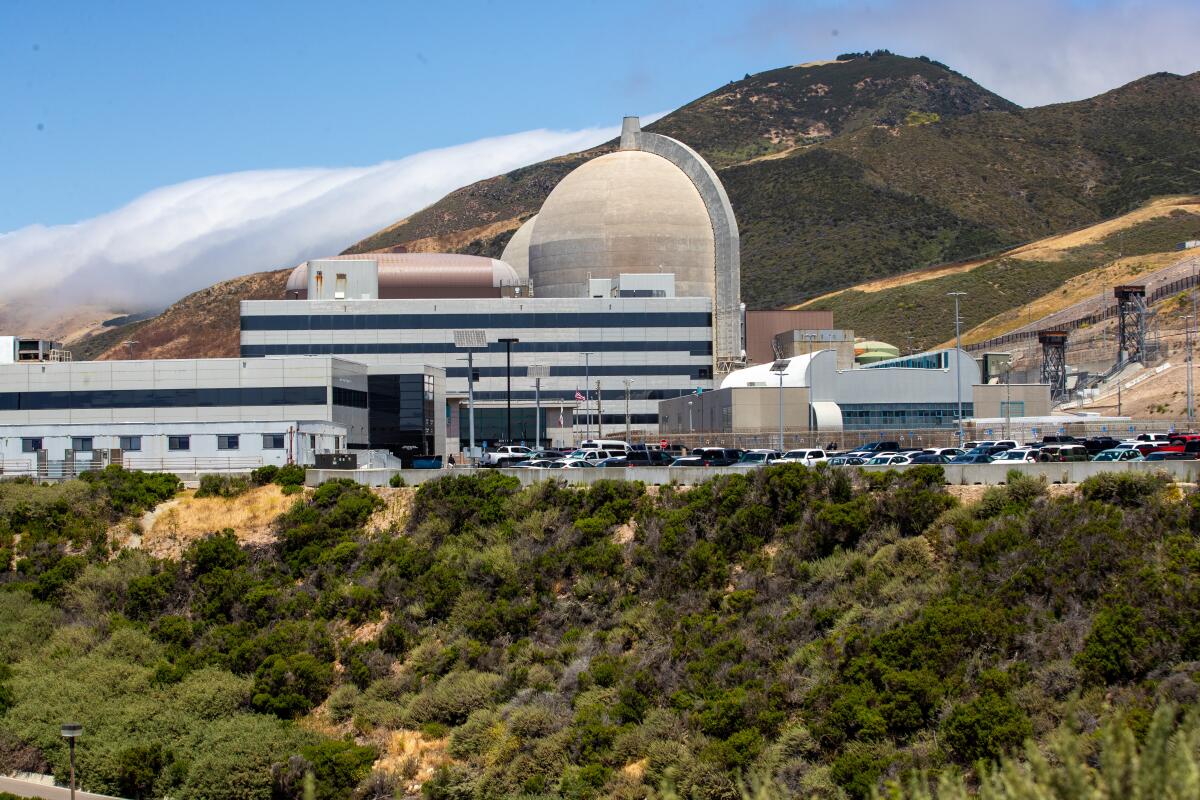Boiling Point: A setback for nuclear power

- Share via
More nuclear energy would absolutely make it easier to confront the climate crisis.
I want to be on the record as saying that, for the sake of all the nuclear obsessives who see anything written about climate that isn’t focused on atomic power — and whoever wrote it — as delusional. So I’ll say unequivocally: Definitely, if we could generate more zero-carbon electricity from nuclear reactors that ran 24/7, it would be easier to phase out fossil fuels.
Unfortunately, we just got the latest reminder of why it’s not so easy.
You're reading Boiling Point
Sammy Roth gets you up to speed on climate change, energy and the environment. Sign up to get it in your inbox twice a week.
You may occasionally receive promotional content from the Los Angeles Times.
HuffPost’s Alexander C. Kaufman broke the news Friday afternoon that NuScale — an Oregon-based nuclear startup that has gotten lots of hype for its next-generation reactor design and won large amounts of federal funding — was laying off a large chunk of its workforce. NuScale announced Monday that it had fired 154 people, more than a quarter of its employees.
What went wrong? Rising costs recently prompted the company to cancel its first project, which would have been built in Idaho and supplied electricity to Utah. Similar economic challenges have bedeviled other startups working to develop “small modular reactors,” which in theory would be faster and cheaper to build than traditional nukes — if someone could crack the code.
Again, it would be great if someone could crack the code.
As I’ve noted previously while reporting on Diablo Canyon, California’s last nuclear plant, we’re unlikely to see much new construction of traditional reactors, due in part to skyrocketing costs and in part to public concerns over earthquakes, radiation and water pollution. But next-generation nuclear technologies could help clean up the electric grid, keeping the lights on when the sun isn’t shining, the wind isn’t blowing and short-duration lithium-ion batteries run out of juice.
That said, they’re not the only option. And the NuScale layoffs are a good reminder of why we need others.
I know I’m not going to persuade the hard-core nuclear fanatics that we shouldn’t count on atomic energy to solve all our problems. But for those of you concerned about radiation yet intrigued by the idea of a 24/7 clean energy source — or those who are a lot more worried about global warming than about nuclear meltdowns — here are my takeaways.
We need to keep investing in a wide variety of climate solutions, even when it feels safer to stick to stuff that we know works — and to stay away from stuff that makes us uncomfortable. Putting all our eggs in one basket — or even two or three or four — is not the right answer when failure means a deadlier, more dangerous world where wildfires and extinctions run rampant.
So it’s a good thing that the Biden administration is calling for a tripling of nuclear energy generation globally by 2050. It’s a good thing that the federal government and wealthy individuals such as Bill Gates continue to invest in small modular reactors.
It’s even a good thing that so many people on social media and in my inbox care so much about nuclear power.
So to all you nuclear fans engaged in thoughtful, informed dialogue that recognizes the need for a variety of climate solutions: Thank you, please keep it up. And to those of you not willing to expand your horizons: Please know I can’t help you.
On that note, here’s what else is happening around the West.
TOP STORIES

It’s not just DDT dumped along the ocean floor off the Southern California coast — there are a bunch of World War II-era weapons down there too. Here’s the latest mind-boggling story about undersea pollution by my L.A. Times colleague Rosanna Xia, who also broke the DDT story with this epic investigation in 2020. Elsewhere along the Pacific coast, homeowners in San Mateo County are suing the California Coastal Commission over its refusal to let them build a sea wall — a case whose outcome could have implications for our response to sea level rise up and down the state, Paul Rogers writes for the Mercury News.
California’s five biggest climate-polluting industrial facilities are oil refineries — two in the L.A. area and three in the Bay Area. That’s according to federal data, reported here by the San Francisco Chronicle’s Kurtis Alexander. In theory, the state’s cap-and-trade program to reduce carbon emissions should bring down pollution at the refineries — eventually. Climate activists to our north say Washington state’s new carbon cap is working better. But critics blame the carbon cap for high gasoline prices, and voters may have a chance to throw it out at the ballot box, Grist’s Kate Yoder writes.
Many of the farmworkers growing America’s winter vegetables in the scorching desert outside Yuma, Ariz., don’t have access to well-cooled homes nearby — and as a result, their bodies have trouble recovering from days in the hot fields. That’s what I learned from this important story by the Arizona Republic’s Joan Meiners, which illuminates the close connection between tackling climate change and addressing the housing shortage for some of our nation’s most vulnerable people.
POLITICAL CLIMATE

“We need three votes, and you’ve got two of them right here.” So said Mel Levine — then-president of the L.A. Department of Water and Power’s board of commissioners — during a 2019 phone call with a company looking for a big contract from the public agency. The private call included board member Cynthia McClain-Hill, DWP’s current president, according to this story by The Times’ Dakota Smith and Richard Winton. I’m curious whether McClain-Hill — whose agency is central to the city’s push for 100% clean energy — will address the story at this week’s board meeting, which starts at 10 a.m. Tuesday and can be watched here.
California’s Legislative Analyst’s Office has concluded that urban water conservation targets proposed by state officials may be too expensive and too hard for cities to achieve. “Whether the benefits of the new rules ultimately will outweigh the costs is unclear,” the office told Sacramento lawmakers, as reported by CalMatters’ Rachel Becker. “These doubts are particularly worrisome given we find that suppliers will face notable challenges complying.” Some water experts were skeptical, noting that conservation is a relatively low-cost way to deal with longer, hotter droughts being made worse by climate change.
“A wildfire accidentally started by the federal government drove them from their homes and destroyed the things they loved most about their land. The government will pay them only for things with a price tag.” So write Source New Mexico’s Patrick Lohmann and ProPublica’s Byard Duncan, in a moving story examining the Biden administration’s refusal to compensate victims of the Hermits Peak-Calf Canyon fire for “noneconomic” damages such as pain and suffering. The blaze was triggered by two prescribed burns that got out of control, becoming the largest fire in New Mexico’s recorded history.
THE ENERGY TRANSITION
Several Democrats in the U.S. Senate — including Montana’s Jon Tester, Ohio’s Sherrod Brown and Arizona’s Mark Kelly — are pushing back against a Biden administration plan to slash climate pollution from power plants. Details here from Tom Lutey at the Billings Gazette, whose story serves as a reminder that fossil-fuel jobs and their political symbolism still carry a lot of weight, even among Democrats. In Montana, at least, maybe it will start to change the equation — at least a little bit? — that the state will soon have more megawatts of wind power than coal power, as Amanda Eggert reports for Montana Free Press.
Environmental groups have asked California’s 1st District Court of Appeal — where three judges recently upheld a decision by state officials to reduce rooftop solar incentives — for a rehearing of their lawsuit. Here’s the story from Rob Nikolewski at the San Diego Union-Tribune. (Check out my previous reporting on the legal battle.) Idaho, meanwhile, just became the latest state to reduce rooftop solar incentives, as Angela Palermo reports for the Idaho Statesman.
A new survey offers up useful data on what might convince people to get fossil fueled appliances out of their homes and invest in clean energy. The main finding isn’t shocking, Canary Media’s Alison F. Takemura writes: Cost is the biggest factor.
AROUND THE WEST
California has between 3,200 and 4,500 mountain lions, scientists have concluded after years of study — not as many as previously thought. But just having the estimate is a good starting point for conservation efforts, my L.A. Times colleague Louis Sahagún writes. “Having as much data as possible is always best for managing species like that, especially in places where wilderness is overcrowded with people,” one scientist told him. In other wildlife news, I didn’t realize feral dogs were such a big problem for livestock in rural California — a topic The Times’ Susanne Rust explored here.
Will the Biden administration’s plan to elevate the role of conservation on public lands lead to greater protection for the wildlife corridors traversed by big game such as mule deer, elk and pronghorn? Adam Goldstein has a great story for Inside Climate News attempting to answer that tough question, focused on Wyoming. “Where wildlife advocates see hope, energy and ranching interests fear an attack on the ‘Western way of life,’” Goldstein writes.
The Tijuana Estuary is “a vestige of another era, and proof of what can happen when people work together, holding on to their vision even when it seems futile.” So writes Ruxandra Guidi in a beautiful story about the salt marshes where the Tijuana River flows into the Pacific Ocean near the U.S.-Mexico borders — and the lessons they hold for adapting to climate change.
ONE MORE THING

It’s hard for me to be upset about any government investment in public transit. That said ...
The Times’ Rachel Uranga reported Monday that the Biden administration has pledged up to $1 billion for an elevated train that will connect SoFi Stadium and other L.A. County entertainment venues with the nearby Metro line, a project that local officials are trying to finish before the 2028 Olympic Games. It sounds great, and I hope it will get more people out of their cars.
But it’s hard not to cringe seeing so much public money going toward a train that’s poised to benefit billionaire L.A. Rams owner Stan Kroenke, whose SoFi Stadium was built without the environmental review typically required in California.
Climate solutions and capitalism can make for strange bedfellows — a reality I’ve explored before and will again.
This column is the latest edition of Boiling Point, an email newsletter about climate change and the environment in California and the American West. You can sign up for Boiling Point here. And for more climate and environment news, follow @Sammy Roth on X.
Toward a more sustainable California
Get Boiling Point, our newsletter exploring climate change, energy and the environment, and become part of the conversation — and the solution.
You may occasionally receive promotional content from the Los Angeles Times.






